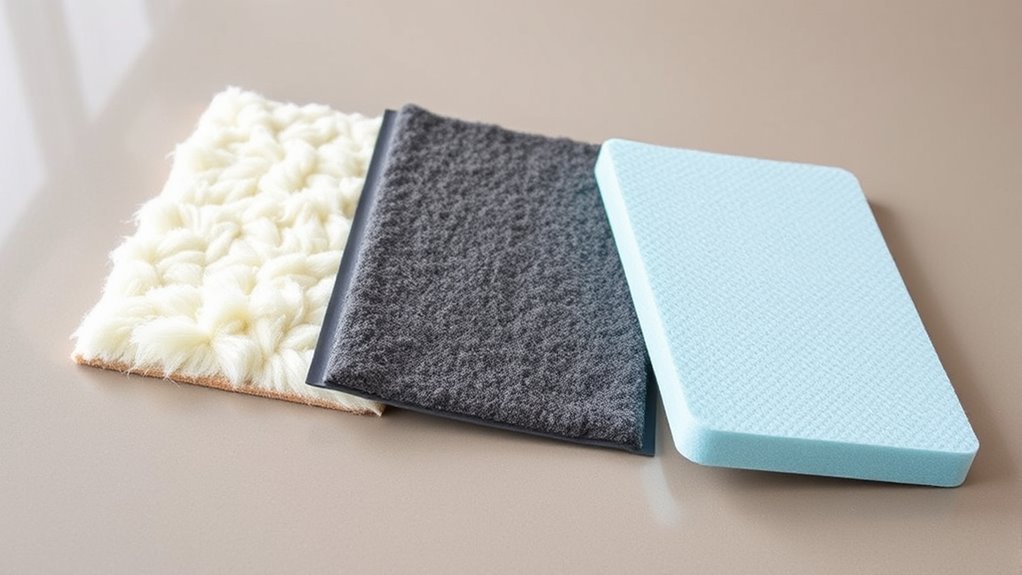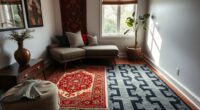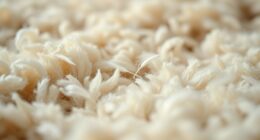For allergy-friendly rug pads, natural rubber and felt options are great choices, as they resist dust and mold. Avoid vinyl and PVC pads, which may off-gas chemicals that trigger allergies. Coconut coir and wool are eco-conscious and low allergen, but some sensitivities may still matter. Coatings like polyurethane or natural wax can improve safety, but durability varies. If you want to understand which material suits your needs best, keep exploring the details here.
Key Takeaways
- Natural rubber, felt, and coconut coir are eco-friendly options less likely to trap allergens, suitable for allergy-sensitive environments.
- Vinyl and PVC rug pads may emit chemicals like VOCs, potentially triggering allergies and sensitivities.
- Coatings like polyurethane and silicone can enhance allergen barriers but should be non-toxic and food-grade when possible.
- Proper ventilation during installation and maintenance reduces allergen buildup and improves indoor air quality.
- Selecting hypoallergenic, chemical-free materials and durable coatings ensures long-term safety and allergen prevention.
Natural Rubber Rug Pads

Are natural rubber rug pads a safe choice for allergy sufferers? Generally, yes. Natural rubber is derived from latex, which many people tolerate well, but some with latex allergies might react. If you’re sensitive, verify that the pad is labeled latex-free or made from synthetic rubber. Natural rubber offers excellent cushioning and grip, preventing slips and protecting your floors. It’s also resistant to mold, mildew, and dust mites, making it a healthier option for allergy-prone individuals. Plus, natural rubber is eco-friendly and biodegradable, adding to its appeal. However, ensure proper ventilation during installation to minimize any potential allergic reactions from the manufacturing process. Additionally, understanding allergy symptoms can help you determine if natural rubber is a suitable choice for you. Overall, natural rubber rug pads can be a safe, supportive choice if you’re aware of your latex sensitivity.
Felt Rug Pads
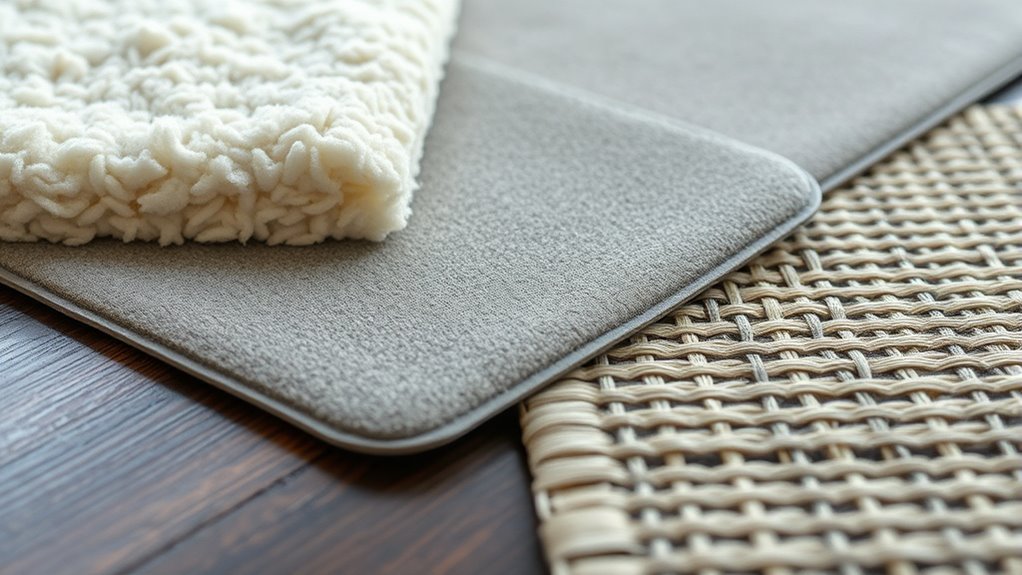
Felt rug pads are a popular choice for those seeking an allergy-friendly option that also provides excellent comfort and support. Made from natural wool or recycled fibers, they create a soft, cushioned layer between your rug and floor. Wool felt is dense and durable, helping to reduce noise and prevent slipping without the use of adhesives or chemicals. Since felt rug pads are dense and tightly woven, they don’t trap dust or allergens easily, making them a good choice for allergy sufferers. However, if you’re sensitive to wool, you may want to deliberate hypoallergenic alternatives or synthetic options. Overall, felt rug pads offer a natural, supportive foundation for your rugs while maintaining a low allergen profile.
Vinyl and PVC Rug Pads

Considering options for allergy-friendly rug pads? Vinyl and PVC rug pads are common choices because they’re durable and affordable. However, they can pose allergy risks if they contain certain chemicals like phthalates or volatile organic compounds (VOCs). These substances may off-gas into your home, potentially triggering allergies or respiratory issues. If you’re sensitive, look for PVC or vinyl pads labeled as low-VOC or non-toxic. Keep in mind, some vinyl and PVC materials are made with additives that could cause irritation, especially for those with chemical sensitivities. To avoid this, opt for pads that specify they’re free from harmful chemicals. While vinyl and PVC are easy to find and inexpensive, they may not be the best choice if you’re aiming for an allergy-friendly environment. Material safety considerations are important when selecting products for sensitive individuals.
Memory Foam Rug Pads
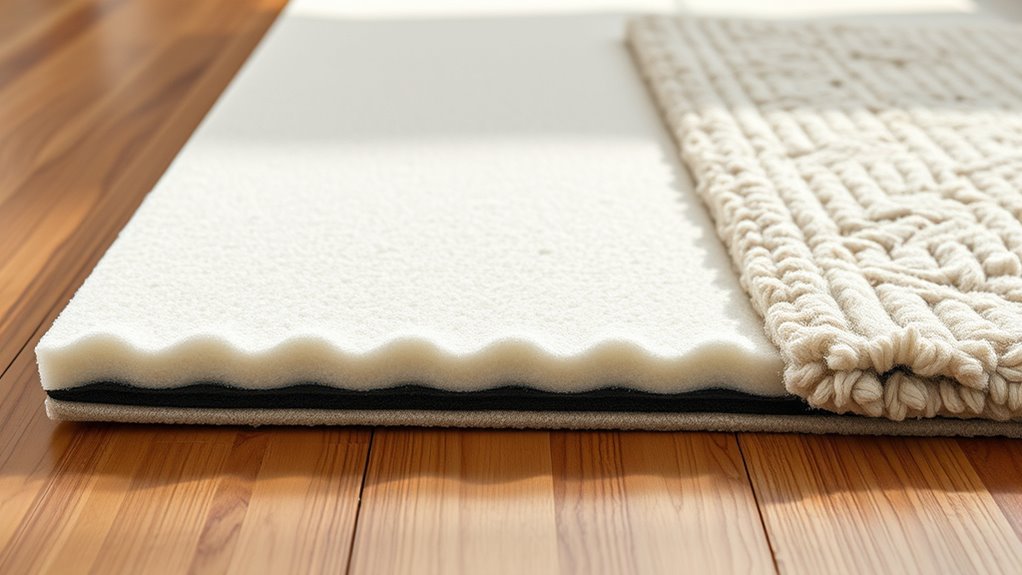
Memory foam rug pads offer a comfortable and supportive cushioning option, making your rugs feel plush underfoot. They conform to the shape of your feet and provide extra padding, which can make walking on your rug more pleasant. These pads help reduce pressure points and absorb shock, protecting both your flooring and rug fibers. Since memory foam is dense, it minimizes shifting and bunching, keeping your rug securely in place. However, be aware that memory foam can trap dust and allergens over time, so regular cleaning is essential. While they’re excellent for added comfort, they may not be the best choice if you have sensitivities to certain chemicals or scents used in manufacturing. Overall, memory foam rug pads blend comfort with support, enhancing your rug experience.
Coconut Coir Rug Pads

Coconut coir rug pads are an eco-friendly choice that provides natural grip and stability for your rugs. Made from natural coconut husks, they help keep your rug in place without slipping or sliding. These pads are biodegradable, renewable, and chemical-free, making them ideal if you’re sensitive to synthetic materials or want a greener option. Their coarse texture creates excellent traction, reducing the risk of accidents. Plus, coir rug pads are durable and resistant to mold and pests, ensuring long-lasting support. Keep in mind, they may be rough underfoot and can shed fibers initially. If you seek an environmentally conscious, non-toxic, and sturdy rug pad, coconut coir offers a practical solution for allergy sufferers and eco-minded homeowners alike. Color accuracy and contrast are important factors in ensuring the visual appeal and safety of your home decor.
Wool Rug Pads
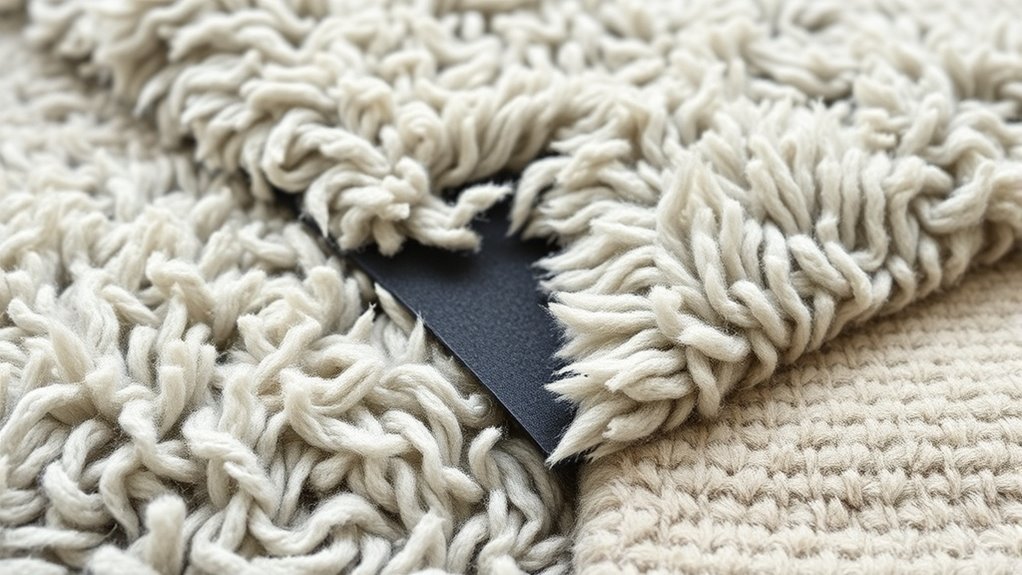
Wool rug pads offer a natural and plush cushioning that enhances your rug’s comfort and durability. Made from real wool fibers, these pads provide excellent insulation and moisture absorption, helping to keep your space warm and dry. Wool’s dense structure adds stability to your rug, reducing slipping and bunching. If you’re sensitive to synthetic materials or chemicals, wool is a good choice because it’s a natural, biodegradable fiber. However, wool rug pads can trap dust and allergens, which might be problematic for allergy sufferers. Regular cleaning can help minimize allergen buildup, but wool’s natural properties make it a cozy, eco-friendly option for those not prone to wool allergies. Overall, wool rug pads combine comfort, insulation, and natural durability for a premium rug experience. Wool’s natural properties also contribute to its ability to absorb moisture and regulate temperature, enhancing your rug’s performance and longevity.
Synthetic Fiber Rug Pads
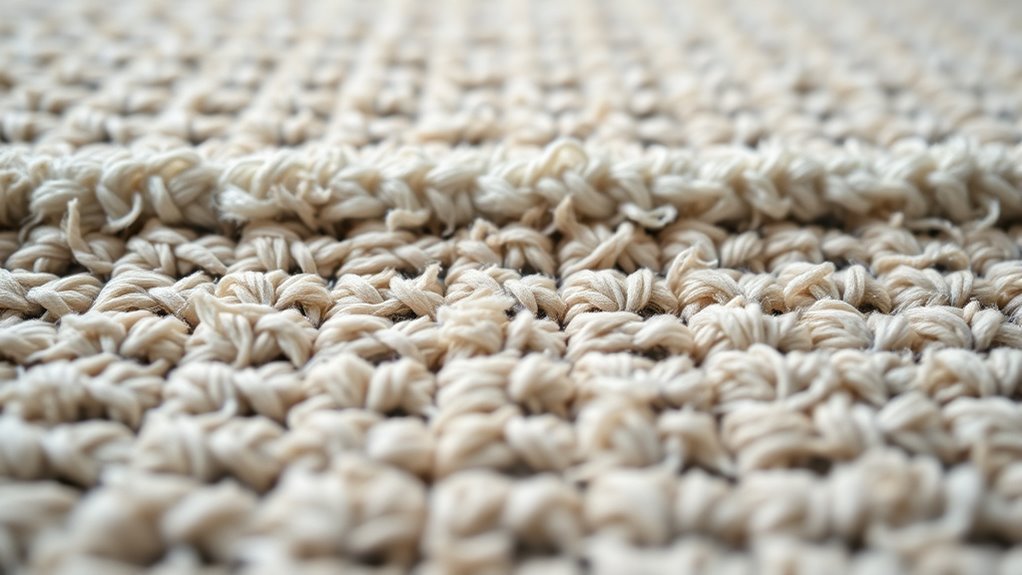
Synthetic fiber rug pads are a popular choice for those seeking affordable and durable padding options. They’re made from materials like polyester, nylon, or polypropylene, offering strength and longevity. These pads resist moisture, mold, and mildew, making them easy to maintain and suitable for high-traffic areas. Plus, synthetic fibers are often less expensive than natural options, fitting into budget-conscious choices.
- Lightweight and easy to install
- Resistant to stains and water damage
- Available in various thicknesses for added cushioning
While synthetic fiber rug pads are durable and economical, they may not be ideal for allergy sufferers if fibers shed or trap dust. Still, their affordability and resilience make them a go-to for many households.
Hybrid Materials and Special Coatings

Hybrid materials combine the best features of different substances to enhance durability and allergy resistance. Special coatings can improve safety and make cleaning easier, but you need to guarantee they’re non-toxic and effective. Understanding how these options prevent allergic reactions helps you choose the safest rug pad for your home. Incorporating paint sprayer technology into rug pad manufacturing can further improve coating application and longevity.
Hybrid Material Benefits
By combining different materials and applying specialized coatings, hybrid rug pads offer notable advantages for allergy sufferers. These combinations create a product that balances durability, breathability, and hypoallergenic properties. You benefit from enhanced air circulation, reducing dust and allergen buildup. Hybrid pads also tend to resist mold and mildew better than single-material options. Additionally, specialized coatings can improve stain resistance and reduce chemical emissions, making the pad safer for sensitive individuals. Regional knowledge indicates that choosing the right materials can also help mitigate issues caused by local environmental factors.
Coating Effectiveness and Safety
Specialized coatings on rug pads markedly enhance their safety and performance, especially for allergy sufferers. These coatings can prevent the transfer of dust, allergens, and chemicals, making your environment safer. They also improve durability and reduce slipping, ensuring your rug stays in place. Some coatings are designed to be hypoallergenic, avoiding the use of harmful substances. To illustrate, here’s a comparison of coating types:
| Coating Type | Benefits | Safety Considerations |
|---|---|---|
| Polyurethane | Water-resistant, durable | Non-toxic options available |
| Silicone | Flexibility, anti-slip properties | Ensure food-grade quality |
| PTFE (Teflon) | Stain resistance | Potential concerns if scratched |
| PVC Coatings | Cost-effective, waterproof | May contain allergens |
| Natural Wax | Eco-friendly, breathable | Requires reapplication |
Additionally, coating durability plays a crucial role in maintaining the long-term safety and effectiveness of rug pads.
Allergic Reaction Prevention
To prevent allergic reactions, manufacturers are turning to innovative hybrid materials and specially formulated coatings that minimize allergen transfer. These advanced solutions combine natural and synthetic components, creating barriers that trap dust, pet dander, and pollen before they reach your nose. Special coatings act as a chemical shield, reducing allergen adhesion on rug pad surfaces. This approach not only limits exposure but also enhances durability and ease of cleaning. Incorporating HEPA filtration properties into rug pads further improves allergen capture and promotes cleaner indoor air.
Frequently Asked Questions
Are Allergy-Friendly Rug Pads Safe for Pets?
You’re wondering if allergy-friendly rug pads are safe for pets. Generally, these pads are made from non-toxic, hypoallergenic materials, making them safe for your furry friends. They don’t emit harmful chemicals or strong odors that could upset your pets’ health. Just make certain you choose high-quality, certified allergy-friendly pads and regularly clean them to keep your home safe and comfortable for both your pets and family.
How Do Allergy-Friendly Rug Pads Impact Indoor Air Quality?
Your indoor air quality could improve dramatically with allergy-friendly rug pads—it’s like breathing in a fresh breeze every day! These pads are designed to trap dust, pet dander, and allergens, preventing them from becoming airborne. By reducing airborne particles, they help create a healthier environment for you and your pets. Plus, their breathable materials prevent mold and mildew, ensuring your indoor air stays clean and safe.
Can Allergy-Friendly Rug Pads Be Reused or Recycled?
You might wonder if allergy-friendly rug pads can be reused or recycled. Many are designed for durability, so you can often reuse them if they stay in good condition. Recycling options depend on the materials; some can be repurposed or processed through specific programs. Always check with manufacturers or local recycling centers to see if your rug pad qualifies. Properly reusing or recycling helps reduce waste and supports eco-friendly practices.
Do Allergy-Friendly Rug Pads Affect the Durability of My Rug?
You might wonder if allergy-friendly rug pads impact your rug’s durability. Generally, these pads are designed to protect your rug, preventing slipping and reducing wear. However, some materials may cushion better than others, extending your rug’s lifespan. You should choose a pad that offers proper support and ventilation. With the right allergy-friendly pad, you’ll likely see improved durability and comfort, keeping your rug in great shape longer.
Are There Any Certifications for Allergy-Friendly Rug Pad Materials?
You’re wondering if allergy-friendly rug pad materials have any certifications. Many reputable manufacturers seek certifications like OEKO-TEX or GreenGuard, which verify that materials are free from harmful chemicals and safe for sensitive individuals. When shopping, look for these labels to ensure the rug pad meets strict standards. Certification helps you confidently choose options that are both allergy-friendly and environmentally responsible, giving you peace of mind in your home.
Conclusion
Ultimately, choosing the right allergy-friendly rug pad involves considering subtle nuances in materials that subtly influence your environment. By thoughtfully exploring options like natural rubber, felt, or wool, you gently steer your space toward comfort and safety. While each material offers its own quiet benefits, trusting your instincts and preferences will softly guide you to a choice that complements your lifestyle. In doing so, you create a welcoming haven where both comfort and care subtly coexist.
